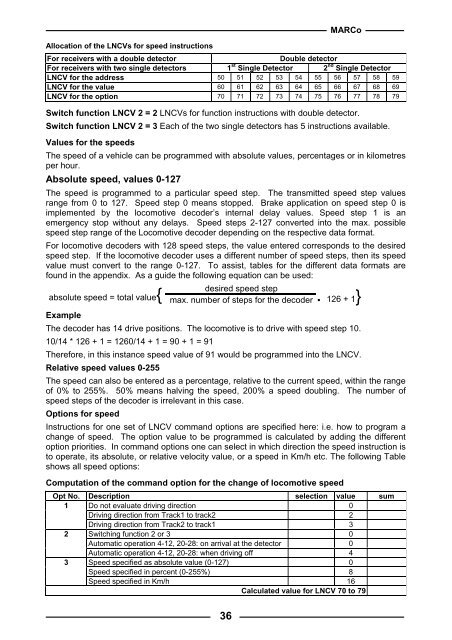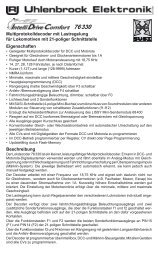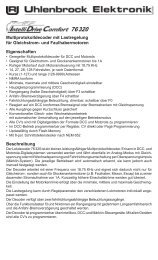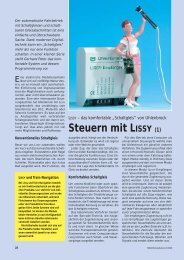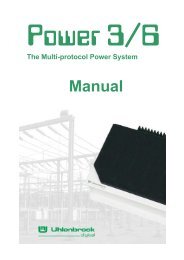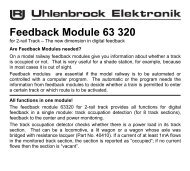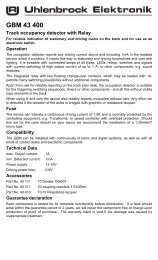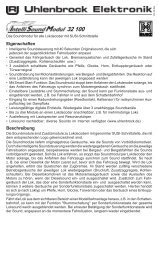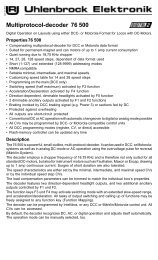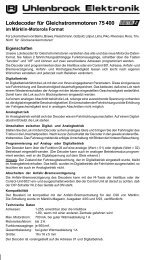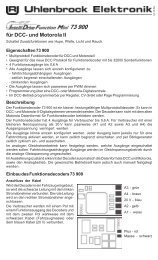Untitled - Uhlenbrock
Untitled - Uhlenbrock
Untitled - Uhlenbrock
You also want an ePaper? Increase the reach of your titles
YUMPU automatically turns print PDFs into web optimized ePapers that Google loves.
Allocation of the LNCVs for speed instructions36MARCoFor receivers with a double detectorDouble detectorFor receivers with two single detectors 1 st Single Detector 2 nd Single DetectorLNCV for the address 50 51 52 53 54 55 56 57 58 59LNCV for the value 60 61 62 63 64 65 66 67 68 69LNCV for the option 70 71 72 73 74 75 76 77 78 79Switch function LNCV 2 = 2 LNCVs for function instructions with double detector.Switch function LNCV 2 = 3 Each of the two single detectors has 5 instructions available.Values for the speedsThe speed of a vehicle can be programmed with absolute values, percentages or in kilometresper hour.Absolute speed, values 0-127The speed is programmed to a particular speed step. The transmitted speed step valuesrange from 0 to 127. Speed step 0 means stopped. Brake application on speed step 0 isimplemented by the locomotive decoder’s internal delay values. Speed step 1 is anemergency stop without any delays. Speed steps 2-127 converted into the max. possiblespeed step range of the Locomotive decoder depending on the respective data format.For locomotive decoders with 128 speed steps, the value entered corresponds to the desiredspeed step. If the locomotive decoder uses a different number of speed steps, then its speedvalue must convert to the range 0-127. To assist, tables for the different data formats arefound in the appendix. As a guide the following equation can be used:desired speed stepabsolute speed = total value{ max. number of steps for the decoder • 126 + 1}ExampleThe decoder has 14 drive positions. The locomotive is to drive with speed step 10.10/14 * 126 + 1 = 1260/14 + 1 = 90 + 1 = 91Therefore, in this instance speed value of 91 would be programmed into the LNCV.Relative speed values 0-255The speed can also be entered as a percentage, relative to the current speed, within the rangeof 0% to 255%. 50% means halving the speed, 200% a speed doubling. The number ofspeed steps of the decoder is irrelevant in this case.Options for speedInstructions for one set of LNCV command options are specified here: i.e. how to program achange of speed. The option value to be programmed is calculated by adding the differentoption priorities. In command options one can select in which direction the speed instruction isto operate, its absolute, or relative velocity value, or a speed in Km/h etc. The following Tableshows all speed options:Computation of the command option for the change of locomotive speedOpt No. Description selection value sum1 Do not evaluate driving direction 0Driving direction from Track1 to track2 2Driving direction from Track2 to track1 32 Switching function 2 or 3 0Automatic operation 4-12, 20-28: on arrival at the detector 0Automatic operation 4-12, 20-28: when driving off 43 Speed specified as absolute value (0-127) 0Speed specified in percent (0-255%) 8Speed specified in Km/h 16Calculated value for LNCV 70 to 79


